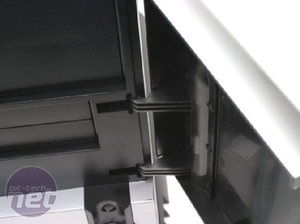
In The Box
Opening up the Silentium T2 reveals two things. Firstly, that the case is extraordinarily cramped inside for a product that boasts is built to house dual GPU setups. Secondly, that this case was clearly designed by a madman.Nothing is how you’d expect it, or even where you’d expect it.
Take the included 500W PSU, for instance (which is curiously called the AX-550F). The power supply in most cases is to be found at the top and rear of the chassis, though occasionally you’ll find them in the bottom rear if you look hard enough. Is this where the ECO 80 (which boasts an 86 percent efficiency and PFC of 95 percent or more) PSU supplied with the case is located then?
No, it’s at the front, directly behind the bezel and with a long power cable strung along to the usual place along the floor of the interior. There’s nothing really wrong with that, I suppose, but it just seems a little odd. Still, if it helps the thermodynamics of the case then we’re all for it.
There are some things however that we’re more concerned about. The cooling fans in the case are the big worry for us as, when we first opened the case, we found that the three fans in the case were loose and all tangled up. Then, when we untangled them, we saw that this was because they weren’t fastened in very well and the case “secured” them to the chassis with small rubber nipples that lodged the fans in place.
We also saw that one of these fans was for the PSU and that the only extra fans in the case were two low-speed 80mmers that were supposed to be positioned in the top of the case. A number of rubber nipples on all the fans had broken, but luckily Arctic Cooling supplies some spares in the box and, with a bit of persistence, we were able to re-fix the fans back in place.
The rubber nipple system is actually a tiny bit clever in its intentions – even though the fans do wobble when they spin they now can’t make any noise at all – but is ultimately far too weak and piddly to be appreciable.
As for the notion of having these rubber barbs hold in a fan on the PSU (yes, on the PSU as the fan is not guarded inside the plastic housing of the power supply), well it just seems a little dangerous. If the fan comes loose, as ours did, then you’ve got an exposed electrical system with no cooling whatsoever. All it would take is for one wire to slip into the unguarded fan and jam the system.
Other areas of the case illustrate the well-intentioned and creative, though poorly executed ideas that have obviously gone into the chassis’ design. The HDD system for instance, while slightly more bearable and well thought out, is still a little bewildering in concept.
Here’s how it works. You take a hard drive, you surround it in sponge (or, if you have two hard drives you just put them on top of each other with nothing in between) screw a cheap heatsink to one side and then wrap it up in Velcro. Literally, that’s it. This means your hard drives are never going to have any proper cooling and will be packed in, surrounded by sponge, vibrating loose the one strip of Velcro supposed to keep them secure.
OK, we all want cases which are quiet – but the idea here is just the tiniest bit ludicrous.
Elsewhere, the case is pretty run of the mill and is exactly what you’d expect from a steel box with plastic details. There are plenty of ventilation grilles in the back that are supposed to suck cold air in, funnelling it up to the dual 80mm fans, but there are no fancy extras like a removable motherboard tray.
On the plus side though, all the standoffs we needed to use came already screwed into the case to make mounting a system in the case a bit quicker.
Speaking of which…

MSI MPG Velox 100R Chassis Review
October 14 2021 | 15:04












Want to comment? Please log in.